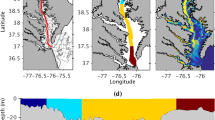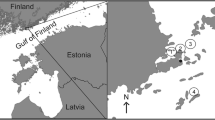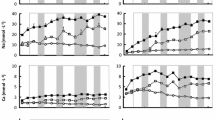Abstract
Internal waves (seiches) are well-studied physical processes in stratified lakes, but their effects on sediment porewater chemistry and microbiology are still largely unexplored. Due to pycnocline oscillations, sediments are exposed to recurrent changes between epilimnetic and hypolimnetic water. This results in strong differences of environmental conditions, which should be reflected in the responses of redox-sensitive biogeochemical processes at both, the sediment–water interface and deeper sediment layers. We tested in a series of mesocosm experiments the influence of seiche-induced redox changes on porewater chemistry and bacterial activity in the sediments under well controlled conditions. Thereby, we excluded effects of changes in current and temperature regimes. For a period of 10 days, intact sediment cores from oligotrophic Lake Stechlin were incubated under constant (either oxic or anoxic) or alternating redox conditions. Solute concentrations were measured as porewater profiles in the sediment, while microbial activity was determined in the upper 0.5 cm of sediment. Oxic and alternating redox conditions resulted in similar ammonium, phosphate, and methane porewater concentrations, while concentrations of each analyte were considerably higher in anoxic cores. Microbial activity was clearly lower in the anoxic cores than in the oxic and the alternating cores. In conclusion, cores with intermittent anoxic phases of up to 24 hours do not differ in biogeochemistry and microbial activities from static oxic sediments. However, due to various physical processes seiches cause oxygen to penetrate deeper into sediment layers, which affects sediment redox gradients and increase microbial activity in seiche-influenced sediments.







Similar content being viewed by others
References
Abril G, Etcheber H, Hir PL, Bassoullet P, Boutier B, Frankignoulle M (1999) Oxic/anoxic oscillations and organic carbon mineralization in an estuarine maximum turbidity zone (The Gironde, France). Limnol Oceanogr 44(5):1304–1315
Allgaier M, Grossart HP (2006) Diversity and seasonal dynamics of Actinobacteria populations in four lakes in northeastern Germany. Appl Environ Microbiol 72(5):3489–3497. doi:10.1128/aem.72.5.3489-3497.2006
Bastviken D, Tranvik L (2001) The leucine incorporation method estimates bacterial growth equally well in both oxic and anoxic lake waters. Appl Environ Microbiol 67(7):2916–2921. doi:10.1128/aem.67.7.2916-2921.2001
Brand A, Dinkel C, Wehrli B (2009) Influence of the diffusive boundary layer on solute dynamics in the sediments of a seiche-driven lake: a model study. J Geophys Res 114(12):G01010. doi:10.1029/2008jg000755
Bryant LD, Lorrai C, McGinnis DF, Brand A, Wüest A, Little JC (2010) Variable sediment oxygen uptake in response to dynamic forcing. Limnol Oceanogr 55(2):950–964
Buesing N, Gessner MO (2003) Incorporation of radiolabeled leucine into protein to estimate bacterial production in plant litter, sediment, epiphytic biofilms and water samples. Microb Ecol 45(3):291–301. doi:10.1007/s00248-002-2036-6
Canfield DE, Jørgensen BB, Fossing H, Glud R, Gundersen J, Ramsing NB, Thamdrup B, Hansen JW, Nielsen LP, Hall POJ (1993a) Pathways of organic carbon oxidation in three continental margin sediments. Mar Geol 113(1–2):27–40. doi:10.1016/0025-3227(93)90147-n
Canfield DE, Thamdrup B, Hansen JW (1993b) The anaerobic degradation of organic matter in Danish coastal sediments: iron reduction, manganese reduction, and sulfate reduction. Geochim Cosmochim Acta 57(16):3867–3883. doi:10.1016/0016-7037(93)90340-3
Chanton JP, Martens CS, Goldhaber MB (1987) Biogeochemical cycling in an organic-rich coastal marine basin. 7. Sulfur mass balance, oxygen uptake and sulfide retention. Geochim Cosmochim Acta 51(5):1187–1199. doi:10.1016/0016-7037(87)90211-0
Cole JJ, Pace ML, Caraco NF, Steinhart GS (1993) Bacterial biomass and cell size distributions in lakes: more and larger cells in anoxic waters. Limnol Oceanogr 38(8):1627–1632
Eckert W, Didenko J, Uri E, Eldar D (2003) Spatial and temporal variability of particulate phosphorus fractions in seston and sediments of Lake Kinneret under changing loading scenario. Hydrobiologia 494(1):223–229. doi:10.1023/a:1025474517703
Frenzel P, Thebrath B, Conrad R (1990) Oxidation of methane in the oxic surface layer of a deep lake sediment (Lake Constance). FEMS Microbiol Lett 73(2):149–158. doi:10.1111/j.1574-6968.1990.tb03935.x
Glud RN, Berg P, Fossing H, Jørgensen BB (2007) Effect of the diffusive boundary layer on benthic mineralization and O2 distribution: a theoretical model analysis. Limnol Ocenaogr 52(2):547–557
Gonsiorczyk T, Casper P, Koschel R (2003) Long-term development of the phosphorus accumulation and oxygen-consumption in the hypolimnion of oligotrophic Lake Stechlin and seasonal variations in the pore water chemistry of the profundal sediments. Ergebnisse der Limnologie 58:73–86
Hedges JI, Keil RG (1995) Sedimentary organic matter preservation: an assessment and speculative synthesis. Mar Chem 49(2–3):81–115. doi:10.1016/0304-4203(95)00008
Jorgensen BB, Revsbech NP (1985) Diffusive boundary layers and the oxygen uptake of sediments and detritus. Limnol Oceanogr 30(1):111–122
Kirchman DL (1993) Leucine incorporation as a measure of biomass production by heterotrophic bacteria. In: Kemp PF, Sherr BF, Sherr EB, Cole JJ (eds) Curr Meth Aqut Microl Ecol. Lewis Publishers, New York, pp 509–512
Kirillin G, Engelhardt C, Golosov S (2008) A mesoscale vortex in a small stratified lake. Environ Fluid Mech 8(4):349–366. doi:10.1007/s10652-008-9101-8
Kirillin G, Engelhardt C, Golosov S (2009) Transient convection in upper lake sediments produced by internal seiching. Geophys Res Lett 36:L18601. doi:10.1029/2009gl040064
Koroleff F (1976) Determination of phosphorus. In: Grasshoff K (ed) Methods in seawater analysis, vol 3. Verlag Chemie, Weinheim, pp 125–131
Koschorreck M, Kleeberg A, Herzsprung P, Wendt-Potthoff K (2007) Effects of benthic filamentous algae on the sediment–water interface in an acidic mining lake. Hydrobiologia 592(1):387–397. doi:10.1007/s10750-007-0776-5
Kristensen E (2000) Organic matter diagenesis at the oxic/anoxic interface in coastal marine sediments, with emphasis on the role of burrowing animals. Hydrobiologia 426(1):1–24. doi:10.1023/a:1003980226194
Kristensen E, Ahmed SI, Devol AH (1995) Aerobic and anaerobic decomposition of organic matter in marine sediment: which is fastest? Limnol Oceanogr 40(8):1430–1437
Lee C (1992) Controls on organic carbon preservation: the use of stratified water bodies to compare intrinsic rates of decomposition in oxic and anoxic systems. Geochim Cosmochim Acta 56(8):3323–3335. doi:10.1016/0016-7037(92)90308-6
Lorke A, Muller B, Maerki M, Wuest A (2003) Breathing sediments: the control of diffusive transport across the sediment–water interface by periodic boundary–layer turbulence. Limnol Oceangr 48(6):2077–2085
McDonough RJ, Sanders RW, Porter KG, Kirchman DL (1986) Depth distribution of bacterial production in a stratified lake with an anoxic hypolimnion. Appl Environ Microbiol 52(5):992–1000
Pace M, Prairie Y (2005) Respiration in lakes. In: del Giorgio P, Williams P (eds) Respiration in aquatic systems. Oxford University Press, Oxford, pp 103–121
Ramsing A, Růžička J, Hansen EH (1980) A new approach to enzymatic assay based on flow-injection spectrophotometry with acid-base indicators. Anal Chim Acta 114:165–181. doi:10.1016/s0003-2670(01)84288-4
Sander BC, Kalff J (1993) Factors controlling bacterial production in marine and freshwater sediments. Microb Ecol 26(2):79–99. doi:10.1007/bf00177045
Simon M, Azam F (1989) Protein content and protein-synthesis rates of planktonic marine bacteria. Mar Ecol Prog Ser 51(3):201–213. doi:10.3354/meps051201
Svensson G, Anfält T (1982) Rapid determination of ammonia in whole blood and plasma using flow injection analysis. Clin Chim Acta 119(1–2):7–14. doi:10.1016/0009-8981(82)90399-0
Van Senden DC, Imboden DM (1989) Internal seiche pumping between sill-separated basins. Geophys Astro Fluid 48(1–3):135–150. doi:10.1080/03091928908219530
Acknowledgments
We thank Uta Mallok and Elke Mach for technical assistance and Michael Sachtleben and Roman Degebrodt for support during field sampling. Further, we thank Kirsten Pohlmann for statistical and language support, Volkmar Gerhardt for technical assistance with the experimental equipment and Thomas Mehner and all participants of the “Scientific Writing” course at the IGB for helpful comments and discussions on an earlier stage of this manuscript. Furthermore, we thank Martin Allgaier, Andreas Brand, Christof Engelhardt and all three reviewers for valuable annotations to this manuscript. This study was funded by the German Research Foundation (GR1540/15-1). KA was funded by Terralac, a Grant donated by the Pact for Innovation and Research of the Gottfried Wilhelm Leibniz scientific community.
Author information
Authors and Affiliations
Corresponding author
Rights and permissions
About this article
Cite this article
Frindte, K., Eckert, W., Attermeyer, K. et al. Internal wave-induced redox shifts affect biogeochemistry and microbial activity in sediments: a simulation experiment. Biogeochemistry 113, 423–434 (2013). https://doi.org/10.1007/s10533-012-9769-1
Received:
Accepted:
Published:
Issue Date:
DOI: https://doi.org/10.1007/s10533-012-9769-1




